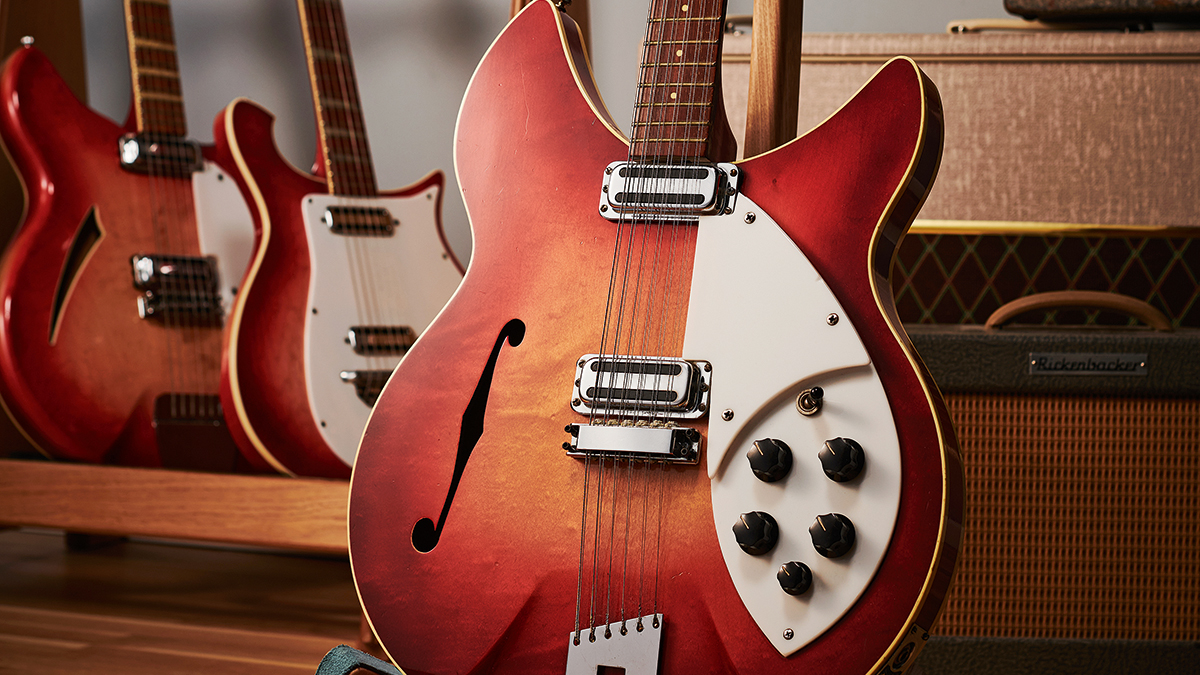The 12-string guitar that defined the ‘60s: in praise of the Rickenbacker Capri
A favourite of The Beatles and The Byrds, these era-defining electrics still resonate

As far as 12-string electric guitars go, it’s hard to beat a Rickenbacker Capri model. The Fender Electric XII is perhaps the greatest competitor in terms of playability and sound, and the Gibson EDS-1275 doubleneck also deserves an honourable mention.
But with The Beatles’ George Harrison and The Byrds’ Roger McGuinn chiming away on Rickenbackers, while topping the charts on both sides of the Atlantic during the mid‑’60s, it’s difficult to argue that a more era-defining 12-string exists.
Comprising six- and 12-string instruments, the ‘300 series’ semi-hollowbody Capri line is to Rickenbacker what the Les Paul is to Gibson, or the Stratocaster is to Fender.
An icon of the guitar world, this timeless design continues to define the company’s identity and, along with the popular Rickenbacker bass family, is its greatest success. The Capri blueprint was originally developed by legendary guitar designer Roger Rossmeisl.
German expat Rossmeisl had honed his craft in Europe building jazz guitars under the Roger brand before emigrating to America in 1953. The master luthier was briefly employed at Gibson before being recruited by Rickenbacker in ’54, then by Fender in ’62, where he also developed numerous models, including the Telecaster Thinline and Coronado.
Prototyped in late ’57 and entering production early the following year, the inaugural Capris comprised four short-scale models (listed in ’58 as the 310, 315, 320 and 325). These were swiftly followed by the full-scale standard (330, 335, 340 and 345) and deluxe (360, 365, 370 and 375) models. (The ascending model numbers correspond to spec as follows: two pickups/no vibrato; two pickups/vibrato; three pickups/no vibrato; and three pickups/vibrato.)
The vast majority of the first batch consisted of 325s à la John Lennon, and, by a freaky twist of fate, the young Beatle bought the very first Capri made (serial V81) in 1960 in Hamburg after it was shipped to its maker Rossmeisl’s homeland! Lennon then brought it back to the US, displaying the guitar on national television during the band’s record-breaking The Ed Sullivan Show appearance in February ’64 when 73 million Americans tuned in to watch.
Get The Pick Newsletter
All the latest guitar news, interviews, lessons, reviews, deals and more, direct to your inbox!
1957: ‘Polynesian’ semi-hollow Capri range prototype; carved top
1958: Capri range introduced; flat top; most short-scale with f-hole; long‑scale with slash soundhole
Summer 1963: First 360-style 12-string prototype (Arden); Fireglo finish; gold pickguard; ‘cooker’ knobs
Late 1963: Second 360-style 12-string prototype (Harrison); Fireglo finish; white pickguard; black knobs
1964: 360/12 and 370/12 introduced; rounded top; slash soundhole; bound back; triangular markers; special order ‘OS’ (Old Style) with non-contoured/flat top available
Summer 1964: Rose-Morris (UK distributor) model 1993
1965: 330/12 introduced; non-contoured top; unbound; slash soundhole; dot markers
1966: Jetglo (black) finish option added to Fireglo (sunburst) and Mapleglo/Natural options; 336/12 and 366/12 introduced (converter comb)
1967: Azureglo finish option
1968: Burgundyglo finish option
During the same trip, Rickenbacker boss FC Hall presented Harrison with a prototype Rickenbacker 360/12. The guitarist quickly put the new 12-string to good use on stage and in the studio, creating unprecedented global demand.
Harrison’s 360/12 was developed in ’63, based on the six-string 360 deluxe model, by renowned guitar builder Dick Burke at FC Hall’s behest. It features a double-bound body with a flat/non-contoured top and slash soundhole.
It was the second 360/12 prototype (the first was given to country artist Suzi Arden) and sported Burke’s intuitive tuner arrangement that allowed all 12 machineheads to be fitted on a regular size headstock.
It also debuted Rickenbacker’s now standard practice of placing the octave string on the treble side, thus allowing for punchier attack on the downstroke. In ’64, the 360/12 was put into regular production alongside the 370/12. These rounded-top/bound-back guitars were followed by the non-contoured, unbound 330/12 in ’65.
Within a few short years, the electric 12-string bubble had burst and demand dropped considerably. Nevertheless, those yearning for that classic mid-60s jangle needn’t look any further than a Rickenbacker 12-string Capri.
Rod Brakes is a music journalist with an expertise in guitars. Having spent many years at the coalface as a guitar dealer and tech, Rod's more recent work as a writer covering artists, industry pros and gear includes contributions for leading publications and websites such as Guitarist, Total Guitar, Guitar World, Guitar Player and MusicRadar in addition to specialist music books, blogs and social media. He is also a lifelong musician.
“Finely tuned instruments with effortless playability and one of the best vibratos there is”: PRS Standard 24 Satin and S2 Standard 24 Satin review
Epiphone brings one of Gibson’s most desirable one-off finishes to the masses with Guitar Center-exclusive Widow Les Paul – but it’s been given a twist











